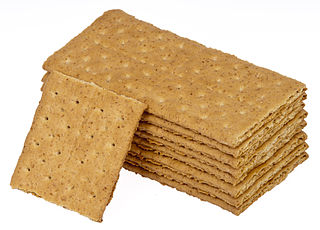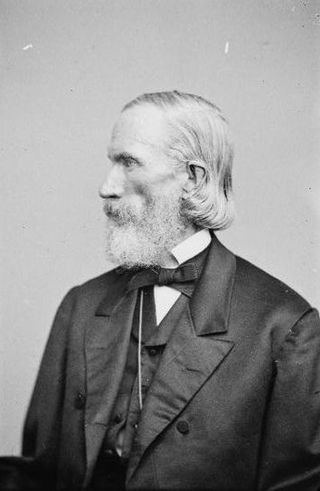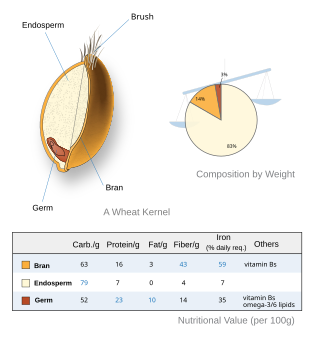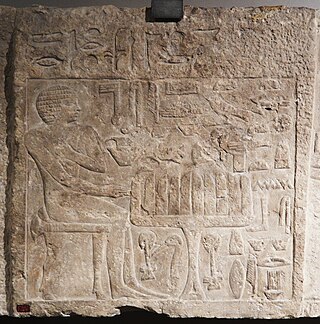
Bread is a staple food prepared from a dough of flour and water, usually by baking. Throughout recorded history and around the world, it has been an important part of many cultures' diet. It is one of the oldest human-made foods, having been of significance since the dawn of agriculture, and plays an essential role in both religious rituals and secular culture.

Flour is a powder made by grinding raw grains, roots, beans, nuts, or seeds. Flours are used to make many different foods. Cereal flour, particularly wheat flour, is the main ingredient of bread, which is a staple food for many cultures. Corn flour has been important in Mesoamerican cuisine since ancient times and remains a staple in the Americas. Rye flour is a constituent of bread in both Central Europe and Northern Europe.

A graham cracker is a sweet flavored cracker made with graham flour that originated in the United States in the mid-19th century, with commercial development from about 1880. It is eaten as a snack food, usually honey- or cinnamon-flavored, and is used as an ingredient in some foods, e.g., in the graham cracker crust for cheesecakes and pies.

Sylvester Graham was an American Presbyterian minister and dietary reformer known for his emphasis on vegetarianism, the temperance movement, and eating whole-grain bread. His preaching inspired the graham flour, graham bread, and graham cracker products. Graham is often referred to as the "Father of Vegetarianism" in the United States of America.

Seitan is a food made from gluten, the main protein of wheat. It is also known as miànjīn, fu, milgogi, wheat meat, gluten meat, or simply gluten. It is made from vital wheat gluten, a flour-like substance primarily consisting of gluten extracted from wheat flour.

A lacto-vegetarian diet is a diet that abstains from the consumption of meat as well as eggs, while still consuming dairy products such as milk, cheese, yogurt, butter, ghee, cream, and kefir.

Orson Squire Fowler was an American phrenologist and lecturer. He also popularized the octagon house in the middle of the nineteenth century.

Pumpernickel is a typically dense, slightly sweet rye bread traditionally made with sourdough starter and coarsely ground rye. It is sometimes made with a combination of rye flour and whole rye grains.

White bread typically refers to breads made from wheat flour from which the bran and the germ layers have been removed from the whole wheatberry as part of the flour grinding or milling process, producing a light-colored flour.
Wheat flour is a powder made from the grinding of wheat used for human consumption. Wheat varieties are called "soft" or "weak" if gluten content is low, and are called "hard" or "strong" if they have high gluten content. Hard flour, or bread flour, is high in gluten, with 12% to 14% gluten content, and its dough has elastic toughness that holds its shape well once baked. Soft flour is comparatively low in gluten and thus results in a loaf with a finer, crumbly texture. Soft flour is usually divided into cake flour, which is the lowest in gluten, and pastry flour, which has slightly more gluten than cake flour.

A whole grain is a grain of any cereal and pseudocereal that contains the endosperm, germ, and bran, in contrast to refined grains, which retain only the endosperm.

Rye bread is a type of bread made with various proportions of flour from rye grain. It can be light or dark in color, depending on the type of flour used and the addition of coloring agents, and is typically denser than bread made from wheat flour. Compared to white bread, it is higher in fiber, darker in color, and stronger in flavor. The world's largest exporter of rye bread is Poland.

Jeremiah Hacker was a missionary, reformer, vegetarian, and journalist who wrote and published The Pleasure Boat and The Chariot of Wisdom and Love in Portland, Maine, from 1845 to 1866.

Brown bread is bread made with significant amounts of whole grain flours, usually wheat sometimes with corn and or rye flours. Brown breads often get their characteristic dark color from ingredients such as molasses or coffee. In Canada, Ireland and South Africa, it is whole wheat bread; in New England and the Maritimes, it is bread sweetened with molasses. In some regions of the US, brown bread is called wheat bread to complement white bread.

A dough conditioner, flour treatment agent, improving agent or bread improver is any ingredient or chemical added to bread dough to strengthen its texture or otherwise improve it in some way. Dough conditioners may include enzymes, yeast nutrients, mineral salts, oxidants and reductants, bleaching agents and emulsifiers. They are food additives combined with flour to improve baking functionality. Flour treatment agents are used to increase the speed of dough rising and to improve the strength and workability of the dough.
Orthopathy or natural hygiene (NH) is a set of alternative medical beliefs and practices originating from the Nature Cure movement. Proponents claim that fasting, dieting, and other lifestyle measures are all that is necessary to prevent and treat disease.

Bread was central to the formation of early human societies. From the Fertile Crescent, where wheat was domesticated, cultivation spread north and west, to Europe and North Africa, and east towards East Asia. This in turn led to the formation of towns, as opposed to the nomadic lifestyle and gave rise to more and more sophisticated forms of societal organization. Similar developments occurred in the Americas with maize and in Asia with rice.
Graham flour is a type of coarse-ground flour of whole wheat named after Sylvester Graham. It is similar to conventional whole-wheat flour in that both are made from the whole grain, but graham flour is ground more coarsely. It is not sifted ("bolted") with a flour dresser after milling. A report from 1913 claimed that bread made from graham flour had a protein content of 12.1% – only slightly less than white wheat flour and essentially the same as whole wheat flour.

Isaac Jennings was an American physician and writer who pioneered orthopathy.
















